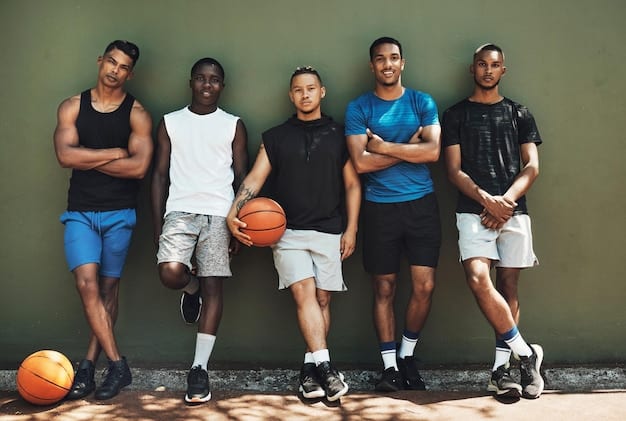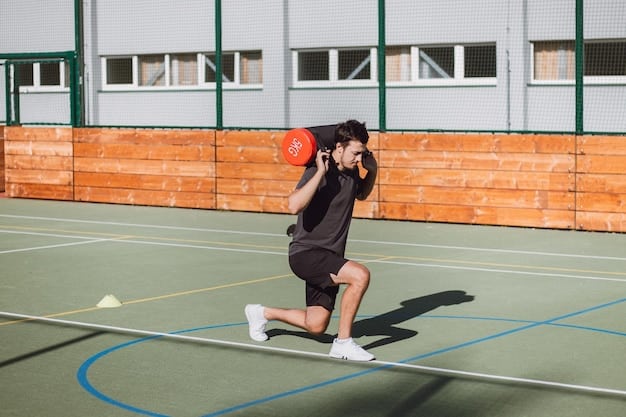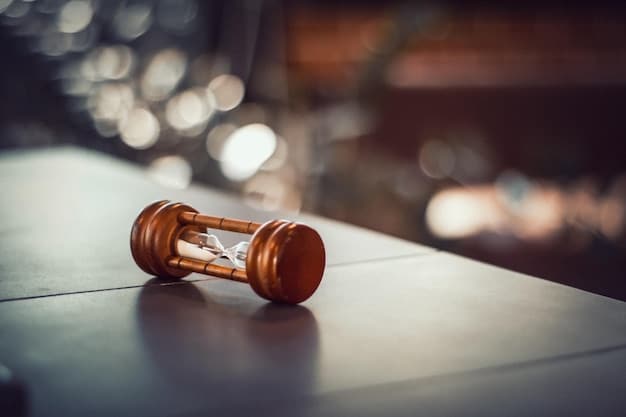NCAA NIL Rules: Impact on High School Athletes in 2025

New NCAA NIL rules are poised to significantly impact local high school athletes in 2025, potentially providing opportunities for endorsements and compensation while also raising concerns about recruitment and competitive balance.
How will the landscape of high school sports be reshaped by the evolving NCAA Name, Image, and Likeness (NIL) rules in 2025? The potential for local high school athletes to benefit from new NCAA NIL rules is generating considerable buzz, but also sparking debates about fairness, eligibility, and the overall impact on amateur athletics.
Understanding NCAA NIL Rules and Their Evolution
The NCAA’s NIL rules have undergone significant changes in recent years, creating new pathways for college athletes to profit from their personal brand. To grasp the implications for high school athletes, it’s crucial to first understand the core principles and ongoing developments of these rules at the collegiate level.
The Basics of NIL
NIL refers to the ability of athletes to receive compensation for the use of their name, image, and likeness. This can include endorsement deals, sponsorships, appearances, and other opportunities to monetize their personal brand.
Recent Changes and Updates
The NCAA’s initial NIL rules were introduced in 2021, but they have been subject to ongoing legal challenges and adjustments. Key areas of change involve the role of collectives, state laws, and attempts to establish a more consistent national standard.
- Collectives: These are third-party organizations that pool resources from boosters and fans to provide NIL deals to athletes.
- State Laws: Many states have enacted their own NIL laws, creating a patchwork of regulations across the country.
- NCAA Guidance: The NCAA continues to release guidance and interpretations of its NIL rules, attempting to clarify ambiguities and address emerging issues.
In conclusion, understanding how NIL rules have evolved at the NCAA level provides a critical foundation for assessing their potential impact on high school athletics. Comprehending the basics and recent changes ensures a better grasp on the complexities and possibilities moving forward.
Potential Benefits for High School Athletes
The implementation of NCAA NIL rules at the high school level could unlock a range of potential benefits for young athletes. From financial rewards to enhanced career opportunities, the prospects are enticing. However, a balanced perspective is necessary to evaluate both the advantages and potential pitfalls.
Financial Opportunities
One of the most significant benefits is the chance for high school athletes to earn money through endorsements, sponsorships, and other NIL activities. This income could help offset the costs of training, travel, and equipment, reducing the financial burden on families.
Increased Exposure and Recognition
NIL deals can provide high school athletes with increased exposure and recognition, helping them build their personal brand and attract attention from college recruiters. This increased visibility can open doors to scholarships and other opportunities.

- Brand Building: NIL allows athletes to start building their brand early, which can be valuable for future career prospects.
- Networking: Engaging with sponsors and businesses can provide valuable networking opportunities.
- Financial Literacy: Managing NIL earnings can teach young athletes important financial literacy skills.
In conclusion, high school athletes could gain financial independence, greater visibility, and valuable life skills. By understanding both the financial and personal development opportunities that NIL provides, athletes can prepare for success.
Challenges and Concerns Regarding Implementation
While the prospect of NIL deals for high school athletes is exciting, it also raises significant challenges and concerns. Ensuring fairness, maintaining amateurism, and preventing undue influence are critical considerations that must be addressed to protect the integrity of high school sports.
Maintaining Amateurism
One of the biggest challenges is preserving the amateur status of high school athletes. Allowing NIL deals could blur the lines between amateur and professional athletics, potentially leading to conflicts of interest and eligibility issues.
Ensuring Fair Competition
Another concern is that NIL deals could create an uneven playing field, with some athletes having access to more resources and opportunities than others. This could exacerbate existing disparities and undermine the principles of fair competition.
The key challenges and concerns include:
- Recruiting Advantages: Wealthy schools or boosters might use NIL deals to attract top talent, creating recruiting imbalances.
- Eligibility Issues: Navigating complex NIL rules can be challenging for athletes and their families, potentially leading to inadvertent violations and loss of eligibility.
- Tax Implications: Athletes and their families need to understand the tax implications of NIL earnings, which can be complex and require professional guidance.
In conclusion, implementing NIL rules at the high school level presents significant challenges regarding amateurism, fair competition, and regulatory compliance. Addressing these concerns is essential to protect the integrity of high school sports and ensure that NIL opportunities benefit all athletes equitably.
Legal and Regulatory Considerations
Implementing NIL rules at the high school level will require careful consideration of legal and regulatory frameworks. State laws, high school athletic associations, and the NCAA all play a role in shaping the landscape of NIL in amateur sports. A clear understanding of these frameworks is crucial for athletes, schools, and policymakers.
State Laws and Regulations
Many states have already enacted NIL laws that govern college athletes. These laws may also extend to high school athletes, or they may require specific amendments to address the unique needs and concerns of this group. Schools must then carefully adhere to state laws.
High School Athletic Associations
High school athletic associations, such as the National Federation of State High School Associations (NFHS), play a crucial role in setting eligibility rules and standards for high school athletes. These organizations will need to develop clear guidelines for NIL activities to ensure compliance and consistency.

- Compliance: Schools and athletes must comply with all applicable laws and regulations, which can be complex and subject to change.
- Transparency: Clear and transparent guidelines are needed to ensure that NIL activities are conducted in a fair and ethical manner.
- Enforcement: Effective enforcement mechanisms are needed to address violations of NIL rules and maintain the integrity of high school sports.
In conclusion, navigating the legal and regulatory landscape of NIL requires a collaborative effort from state legislatures, high school athletic associations, and the NCAA. By establishing clear guidelines and enforcement mechanisms, these stakeholders can help ensure that NIL opportunities benefit high school athletes while preserving the integrity of amateur sports.
How Schools and Coaches Can Prepare
Schools and coaches play a vital role in preparing high school athletes for the opportunities and challenges of NIL. Education, guidance, and support are essential to help athletes make informed decisions and navigate the complexities of the NIL landscape. By proactively addressing NIL issues, schools and coaches can help their athletes maximize the benefits while minimizing the risks.
Education and Training
Schools should provide education and training programs for athletes and their families on topics such as NIL rules, financial literacy, brand management, and legal compliance. These programs can help athletes understand their rights and responsibilities and make informed decisions about NIL opportunities.
Guidance and Support
Coaches can provide guidance and support to athletes on NIL issues, helping them identify potential opportunities, negotiate deals, and manage their personal brand. Coaches can also serve as mentors and role models, helping athletes balance their athletic pursuits with their academic and personal goals.
The key actions that coaches and schools require include:
- Develop Policies: Create clear policies and procedures for NIL activities to ensure compliance with all applicable rules and regulations.
- Provide Resources: Offer resources and support to athletes and their families, such as access to legal and financial advisors.
- Promote Ethical Behavior: Emphasize the importance of ethical behavior and responsible decision-making in all NIL activities.
In conclusion, schools and coaches have a crucial role in preparing high school athletes for the NIL era. Providing education, guidance, and support will help athletes navigate the complexities of NIL and make informed decisions that align with their values and goals. Proactive engagement ensures that NIL activities enhance the overall high school athletic experience while upholding the principles of fair play and amateurism.
Looking Ahead: The Future of NIL in High School Sports
The rollout of NIL rules will evolve over the coming years. Continuous monitoring, adaptability, and collaboration among stakeholders will be essential to shape a future where NIL enhances the high school sports experience. Future changes and innovations should prioritize student athlete well-being while simultaneously promoting fair competition.
Potential Future Developments
The future developments to expect:
- Standardization: Efforts to establish more uniform national standards for NIL rules, reducing the patchwork of state laws and regulations.
- Enhanced Enforcement: Increased scrutiny and enforcement of NIL rules to address violations and maintain the integrity of high school sports.
- Innovative Opportunities: New and creative NIL opportunities for high school athletes, such as partnerships with local businesses and community organizations.
Adaptability and collaboration are key elements of NIL success.
In conclusion, the future of NIL in high school sports is ripe with opportunities and challenges. By embracing a forward-thinking approach, stakeholders can create a system that empowers young athletes while upholding the values of amateurism, fair play, and academic excellence.
| Key Aspect | Brief Description |
|---|---|
| 💰 Financial Gains | Athletes can earn through endorsements and sponsorships. |
| 📈 Visibility Boost | Increased exposure attracts college recruiters. |
| ⚖️ Maintaining Amateurism | Ensuring NIL doesn’t blur amateur status. |
| 📚 Education is Key | Schools prepare students for NIL complexities. |
FAQ
▼
NIL rules allow athletes to profit from their name, image, and likeness through endorsements, sponsorships, and other opportunities. These rules are designed to modernize the way athletes are compensated and recognized for their brand value.
▼
NIL can provide financial opportunities for high school athletes, allowing them to earn money for training, equipment, and other expenses. It also increases their visibility and helps them build their personal brand.
▼
Concerns include maintaining amateurism, ensuring fair competition, and preventing undue influence from wealthy boosters or schools. These issues require careful consideration to protect high school sports’ integrity.
▼
Schools can provide education and training programs on NIL rules, financial literacy, brand management, and legal compliance. They can also offer guidance and support to help athletes navigate NIL opportunities effectively.
▼
The future involves potential standardization of rules, enhanced enforcement, and innovative opportunities. Adaptability and collaboration will be key to creating a system that benefits athletes while upholding amateurism values.
Conclusion
As we look forward to 2025, the introduction of new NCAA NIL rules promises significant transformations for local high school athletes. The ability to leverage their name, image, and likeness opens doors to financial opportunities and increased visibility, but also presents challenges regarding amateurism and competitive balance. Careful planning, robust education, and clear guidelines are vital for schools, coaches, and athletes to navigate this evolving landscape successfully, to ensure a positive and equitable future for high school sports.





